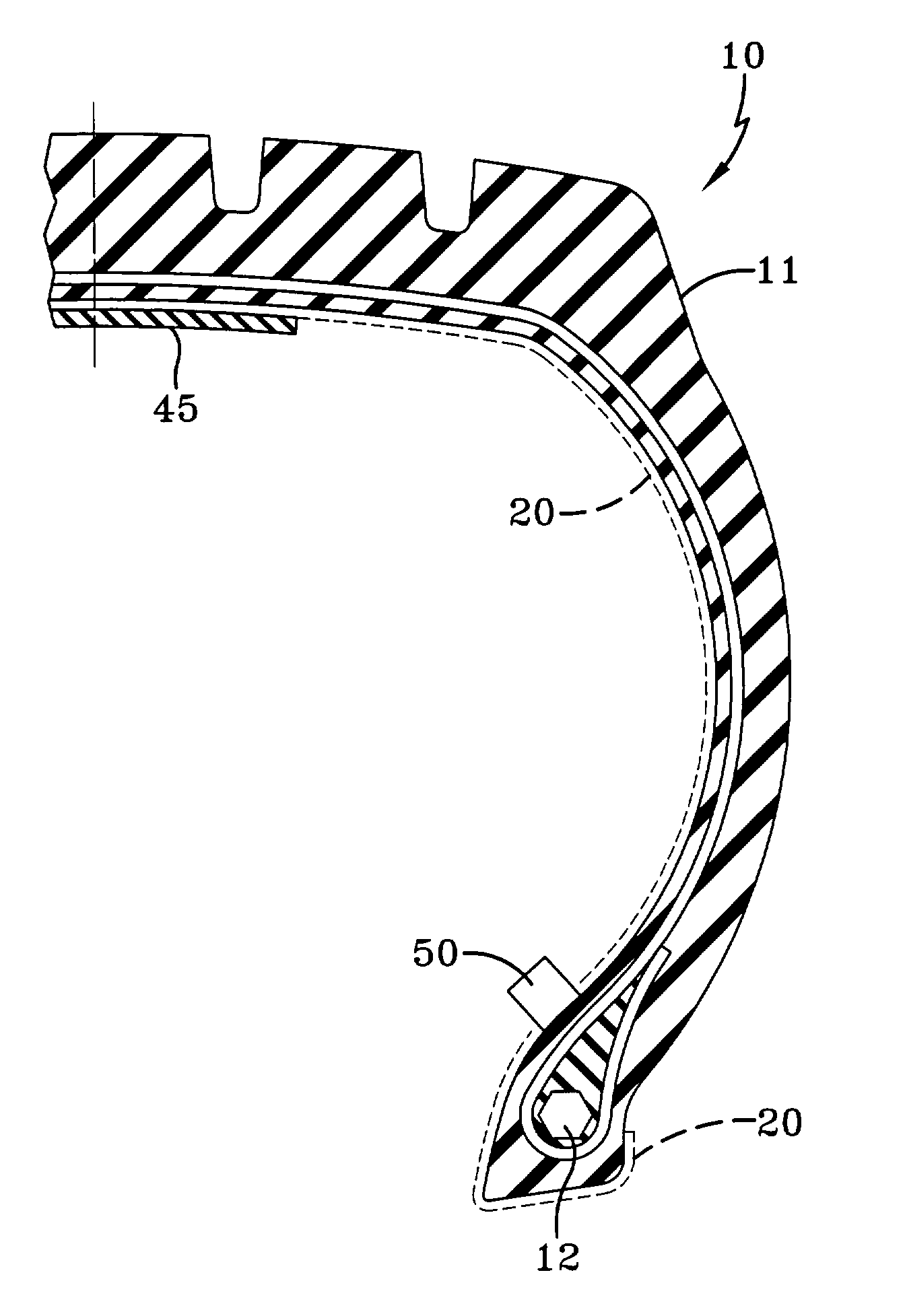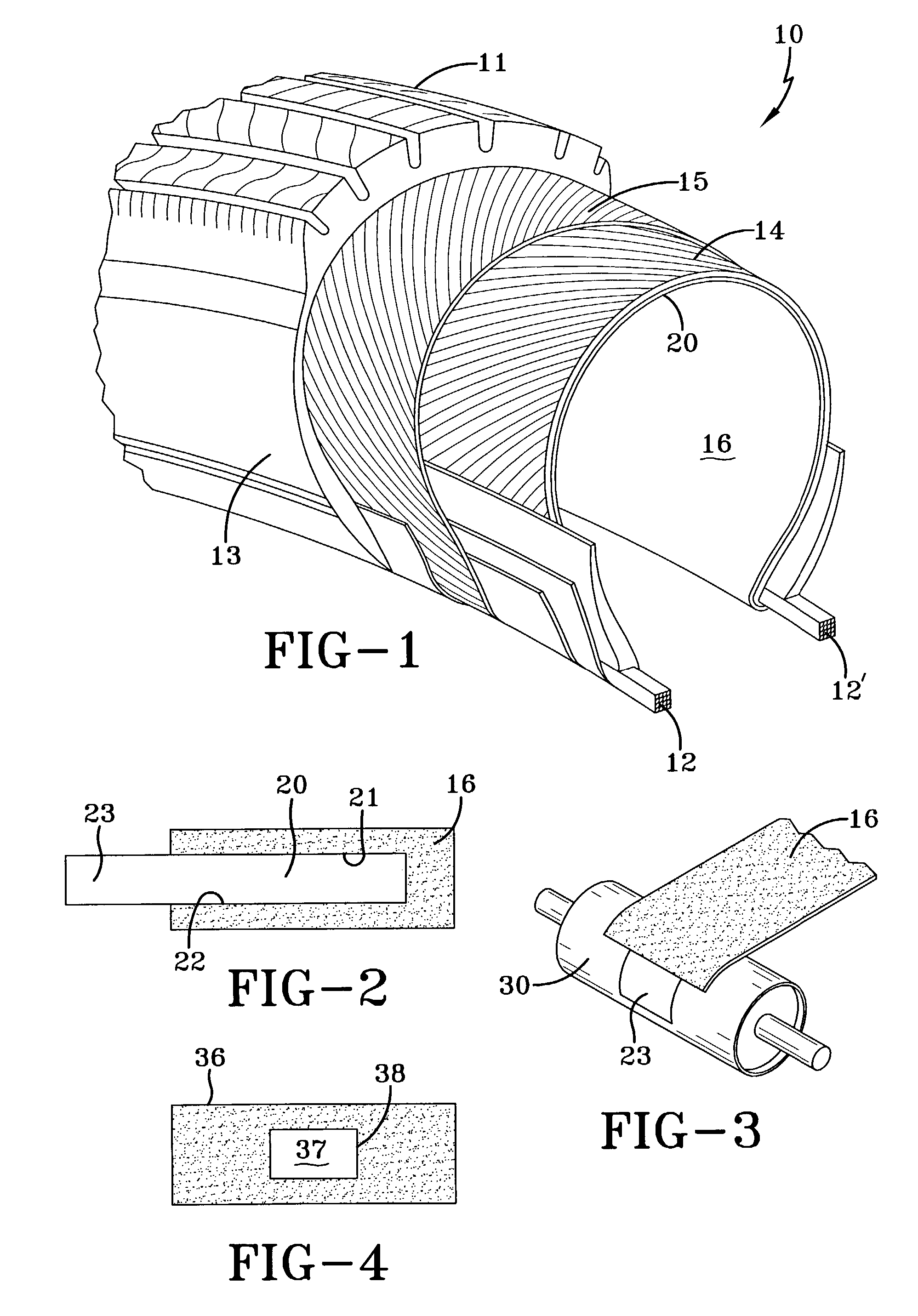Adherent, removable barrier film for tire carcass
a barrier film and tire technology, applied in the direction of instruments, other domestic objects, static/dynamic balance measurement, etc., can solve the problems of dislodging devices, time-consuming and environmental-unfriendly cleaning, and affecting the safety of workers, so as to avoid fouling of mold
- Summary
- Abstract
- Description
- Claims
- Application Information
AI Technical Summary
Benefits of technology
Problems solved by technology
Method used
Image
Examples
example 1
[0052]1A. A bias PBI 22×6.75-10 (22″, 55.9 cm×6.75″, 17 cm-10″, 25.4 cm) 8 ply rating aircraft pneumatic rubber tire (first tire), with a glossy innerliner compounded from 90% bromobutyl rubber and 10% butyl rubber, is built on a drum by first positioning a commercially available continuous strip of thin clear unoriented 6,6-nylon film, 9.5 cm (3.75″) wide and 19 μm (0.75 mils) thick, symmetrically about the longitudinal axis of an innerliner so that from about 2 cm to 5 cm of one end of the nylon strip extends beyond one end of the innerliner as shown in FIG. 2, to provide protection for the entire virgin surface of the innerliner. The opposed longitudinal edges of the nylon strip are stitched into the innerliner with a conventional stitching roller so that the strip and innerliner form a readily-handled assembly. The assembly is circumferentially positioned around the drum with the nylon strip in direct contact with the drum's surface, and a portion of one end of the nylon sheet o...
example 2
Comparison of Adhesive Strength Of Balance Pads Cured To A “Cleaned Surface” and to a “Virgin Cured Surface”:
[0084]To compare the strength of the adhesive bonds, identical balance pads were adhesively secured with the same “fast dry cement” to cleaned surfaces of cured innerliners, and to a virgin cured surface, and all were cured for about three days at room temperature (23° C.).
[0085]A. Innerliners of 80% bromobutyl rubber and 20% natural rubber are protected by each of two different effective barrier films before the tire is cured. Though Mylar film is not acceptable for use in this invention, it provides an effective barrier against release agent. The test is to determine the effect of maintaining a virgin cured surface, irrespective of how it is maintained. Before the tire is cured, the barrier film is coated with Lyndcoat® DV silicone-containing release agent:
[0086]Test sample A1: the barrier film is of 6,6-nylon, 19 μm (0.75 mil) thick.
[0087]Test sample A2: the barrier film i...
example 3
How the Barrier Film Affects Adhesion of Balance Pads with Different Adhesives:
[0093]In a manner analogous to that described in Example 1 above, a green P255 / 60R16 automobile tire carcass is built on a building drum in the conventional manner and a strip of 6,6-nylon film, about 9.5 cm (3.75″) wide is stitched into the innerliner before it is placed on the building drum, so as to provide an annular ring in the cross direction on the inner surface of the innerliner, directly underneath the tread of the completed carcass. One end of the strip overlaps the other affording a pull-tab for ease of removal of the strip. To readily find the pull tab in the cured tire, a 5 cm×9.5 cm piece of white poly(vinyl chloride) (PVC) tape with pressure-sensitive adhesive on one side is attached to the overlapping end of the strip so that the tape is adhesively secured to the underlying nylon film. As before, the interior of the carcass is spray-coated with lining cement, the carcass cured and the nylo...
PUM
| Property | Measurement | Unit |
|---|---|---|
| Temperature | aaaaa | aaaaa |
| Temperature | aaaaa | aaaaa |
| Temperature | aaaaa | aaaaa |
Abstract
Description
Claims
Application Information
 Login to View More
Login to View More - R&D
- Intellectual Property
- Life Sciences
- Materials
- Tech Scout
- Unparalleled Data Quality
- Higher Quality Content
- 60% Fewer Hallucinations
Browse by: Latest US Patents, China's latest patents, Technical Efficacy Thesaurus, Application Domain, Technology Topic, Popular Technical Reports.
© 2025 PatSnap. All rights reserved.Legal|Privacy policy|Modern Slavery Act Transparency Statement|Sitemap|About US| Contact US: help@patsnap.com



